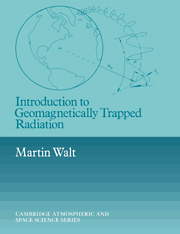Book contents
- Frontmatter
- Contents
- Preface
- List of symbols
- Useful constants
- Geophysical quantities
- Energy equivalents
- 1 The Earth's radiation belts
- 2 Charged particle motion in magnetic and electric fields
- 3 The geomagnetic field
- 4 Adiabatic invariants
- 5 Particle fluxes, distribution functions and radiation belt measurements
- 6 Particle diffusion and transport
- 7 Diffusion in pitch angle
- 8 Diffusion in the L coordinate or radial diffusion
- 9 Summary and comments
- Appendix A Summary of frequently used formulas
- Appendix B Gyration, bounce and drift frequencies in a dipole field
- References
- Index
7 - Diffusion in pitch angle
Published online by Cambridge University Press: 21 September 2009
- Frontmatter
- Contents
- Preface
- List of symbols
- Useful constants
- Geophysical quantities
- Energy equivalents
- 1 The Earth's radiation belts
- 2 Charged particle motion in magnetic and electric fields
- 3 The geomagnetic field
- 4 Adiabatic invariants
- 5 Particle fluxes, distribution functions and radiation belt measurements
- 6 Particle diffusion and transport
- 7 Diffusion in pitch angle
- 8 Diffusion in the L coordinate or radial diffusion
- 9 Summary and comments
- Appendix A Summary of frequently used formulas
- Appendix B Gyration, bounce and drift frequencies in a dipole field
- References
- Index
Summary
Diffusion in the pitch angles of trapped particles is an important redistribution and loss mechanism. Observations of particles with pitch angles inside the loss cone indicate that this process takes place at all L values in which trapping occurs, although the process proceeds more rapidly with increasing L value. At L ≈ 6, which is the magnetic shell whose field lines connect to the auroral zone, rapid pitch-angle diffusion of electrons is a common occurrence. Electrons are fed into the loss cone by multiple deflections, and their subsequent motion into the atmosphere in both the northern and southern hemispheres supplies energy to the polar aurora.
Electron diffusion by collisions with atmospheric atoms
Collisions of electrons with atmospheric atoms is one cause of pitch-angle diffusion. While collisions are the dominant loss for electrons at only very low L values (L < 1.3), they occur at all L for those electrons which mirror at low altitudes. It is a well-understood process, and for this reason it is instructive to derive the diffusion coefficient from the basic formula describing the scattering of electrons by atoms. Because of their greater mass, protons and heavier ions are not scattered appreciably in pitch angle by collisions. The cumulative effect of collisions on ions is to reduce the ion velocity to thermal values while leaving their direction largely unchanged.
- Type
- Chapter
- Information
- Introduction to Geomagnetically Trapped Radiation , pp. 111 - 131Publisher: Cambridge University PressPrint publication year: 1994



